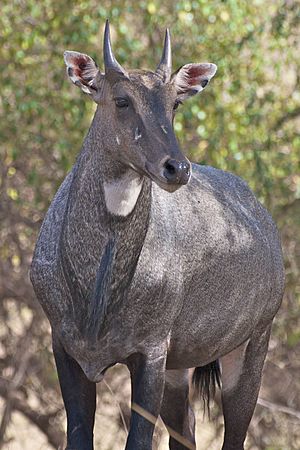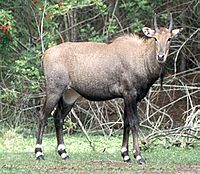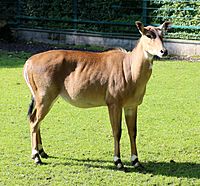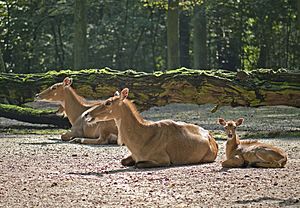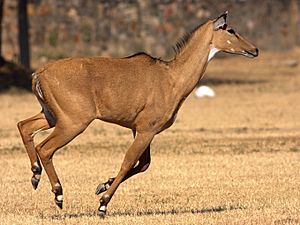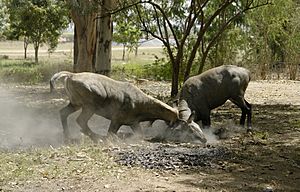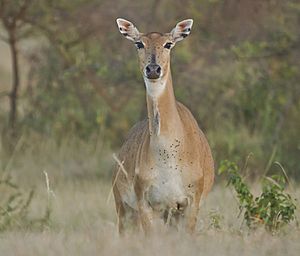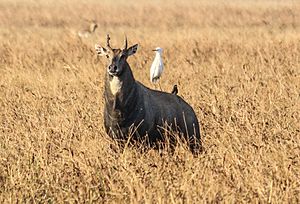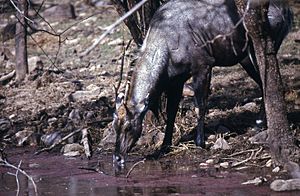Nilgai facts for kids
Quick facts for kids Nilgai |
|
|---|---|
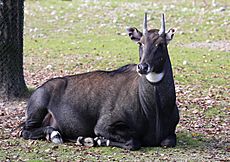 |
|
| Boselaphus tragocamelus | |
| Conservation status | |
| Scientific classification | |
| Kingdom: | |
| Phylum: | |
| Class: | |
| Order: | |
| Family: | |
| Subfamily: | |
| Genus: |
Boselaphus
|
| Species: |
B. tragocamelus
|
| Binomial name | |
| Boselaphus tragocamelus Pall., 1766
|
|
The Nilgai (pronounced "nil-guy") is a large type of antelope. You can often spot them in the wild in northern India and eastern Pakistan. Adult male nilgai look a bit like oxen and are sometimes called Blue bulls because of their bluish-grey fur. The nilgai is actually the biggest antelope found in Asia!
Contents
Description
The nilgai is the largest antelope in Asia. It stands about 1–1.5 metres (3.3–4.9 ft) tall at the shoulder. Its body length is usually between 1.7–2.1 metres (5.6–6.9 ft). Male nilgai are heavier, weighing from 109–288 kilograms (240–635 lb). The heaviest recorded male was 308 kilograms (679 lb). Females are lighter, weighing between 100–213 kilograms (220–470 lb).
Males and females look quite different. Males are larger and have a different color fur. The nilgai is a strong antelope with thin legs. It has a back that slopes downwards and a deep neck with a white patch on its throat. It also has a short mane of hair along its back. You can see two white spots on its face, ears, cheeks, lips, and chin. Its ears are about 15–18 centimetres (5.9–7.1 in) long and have black tips.
Males have a column of coarse hair, called a "pendant," which is about 13 centimetres (5.1 in) long. This hangs below the white throat patch. The tail can be up to 54 centimetres (21 in) long and has a few white spots with a black tip. Their front legs are usually longer, and their legs often have white "socks" markings.
Young nilgai and females are orange to tawny (light brown). Males are much darker, with a bluish-grey fur. Their undersides, the insides of their thighs, and their tails are all white. A white stripe goes from their belly and gets wider as it reaches their rear, forming a patch with dark hair around it. Some nilgai have been seen with almost white fur, though they are not albino. Their hairs are usually 23–28 centimetres (9.1–11.0 in) long and are quite fragile. Males have thicker skin on their head and neck, which helps protect them during fights. Their fur does not keep them very warm in winter, so very cold weather can be dangerous for them.
Only male nilgai have horns, though very few females might have them too. The horns are smooth and straight, about 15–24 centimetres (5.9–9.4 in) long. They usually point backward or forward. Unlike many other bovids (a family of animals that includes cattle and antelopes), nilgai horns do not have rings.
The nilgai has good hearing and eyesight, but its sense of smell is not as strong.
Ecology and Behavior
Nilgai are diurnal, meaning they are mostly active during the day. Studies show they eat most often at dawn, in the morning, in the afternoon, and in the evening. Females and young nilgai usually don't spend much time with males, except when it's time to mate.
Nilgai groups are usually small, with ten or fewer animals. However, sometimes you can see larger groups of 20 to 70 nilgai. In one study in Nepal, the average herd size was three nilgai. Another study in India found that herd sizes changed with the seasons. They form three main types of groups:
- One or two females with their young calves.
- Three to six adult and young adult females with calves.
- Male groups with two to 18 members.
Nilgai are usually calm animals. But if they feel threatened or scared, they can become timid and careful. Instead of hiding, they will run away, sometimes as far as 300 metres (980 ft) or even 700 metres (2,300 ft) if they gallop. They are generally quiet, but they might make short, guttural grunts when alarmed. Females make clicking noises when they are nursing their young. Scared nilgai, especially young ones under five months old, make a coughing roar that lasts about half a second. Other nilgai herds up to 500 metres (1,600 ft) away can hear this sound and respond in a similar way.
In India, nilgai share their home with other animals like the four-horned antelope, chinkara, chital, and blackbuck. They are less often found with gaur and water buffalo. In some areas, nilgai and chinkara prefer places with Acacia and Butea trees.
Large predators like the Indian tiger and the lion might hunt nilgai in India, but they are not their main prey. Leopards also hunt nilgai, but they usually prefer smaller animals. Dholes (wild dogs) mostly attack young nilgai. Other predators include wolves and striped hyenas.
Diet
Nilgai are herbivores, meaning they eat plants. They prefer grasses and herbs. In the dry forests of India, they often eat woody plants (like shrubs and small trees). Studies show that in India, they might eat a mix of grasses and leaves from trees, while in Texas, they mostly eat grass.
Nilgai can handle it better than deer when their habitat is changed by livestock or when plants are degraded. This is possibly because they can reach high branches to eat and don't rely only on plants close to the ground. They can go for long periods without water and don't drink regularly, even in summer.
Reproduction and Life Cycle
A female nilgai is pregnant for eight to nine months. After this, she usually gives birth to one calf or twins. Sometimes, triplets are born! In one study, twins made up as much as 80 percent of the young nilgai born. Births happen most often from June to October in some areas, and from April to August in others.
Calves are born ready to move. They can stand within 40 minutes of being born and start looking for food by their fourth week. Pregnant females go off by themselves before giving birth. Like many other bovid species, nilgai mothers keep their calves hidden for the first few weeks of their lives. This hiding period can last up to a month. Young males often playfully fight by neck-wrestling. Young males leave their mothers at about ten months old to join groups of other young males. Nilgai usually live for about ten years.
Habitat and Distribution
Nilgai like areas with short bushes and scattered trees, such as scrub forests and grassy plains. They are often found in farmlands but rarely in thick forests. In southern Texas, they live in prairies, scrub forests, and oak forests. They are a generalist animal, meaning they can adapt to many different types of habitats.
Even though they don't need much water, nilgai might leave their home areas if all the water sources dry up. Their territories in Texas can be from 0.6 to 8.1 square kilometres (0.23 to 3.13 sq mi) in size.
This antelope is found only in the Indian subcontinent. Large groups live in India, Nepal, and Pakistan. They are no longer found in Bangladesh. Many nilgai live in the Terai lowlands at the bottom of the Himalayas. They are very common across northern India. In 2001, it was estimated that there were one million nilgai in India.
Nilgai were first brought to Texas in the 1920s and 1930s. They were introduced to a large ranch, about 6,000 acres (2,400 ha) big. The wild population grew quickly in the late 1940s and slowly spread to other ranches nearby.
The number of nilgai per square kilometer varies a lot across India. In some national parks, there might be as few as 0.23 to 0.4 nilgai per km2. In other parks, like Ranthambhore National Park, there can be as many as 6.60 to 11.36 nilgai per km2.
Images for kids
-
Nilgai in the Gir National Park, Gujarat (India)
-
Nilgai illustrated by Ustad Mansur for Jahangir (1605–27), c. 1620
See also
 In Spanish: Nilgó para niños
In Spanish: Nilgó para niños



